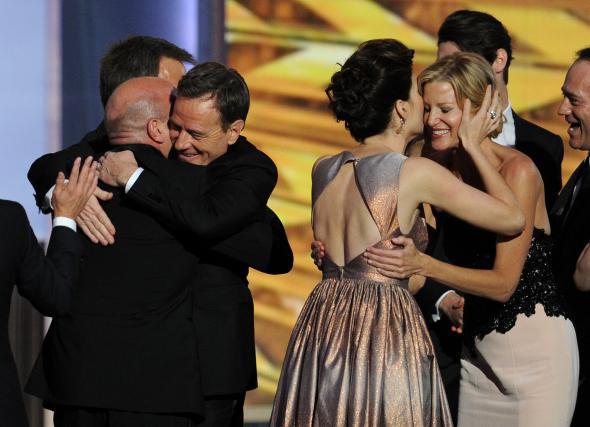Nielsen has been rating TV shows based on their audience since the 1950s, when I Love Lucy and Gunsmoke ruled the air. On Monday, for the first time, it began ranking TV shows based on the number of people tweeting about them as well. In it turns out the Twitter ratings are quite different than the traditional ratings—and, in some ways, more interesting.
For the week of Sept. 23, the most-watched shows by Nielsen’s reckoning were NBC Sunday Night Football, The Big Bang Theory, NCIS, The Big Bang Theory again, NCIS: Los Angeles … you get the picture. The ratings-toppers are, for the most part, formulaic shows that millions of people tune into casually, out of habit, maybe over a TV dinner or just after putting the kids to bed.
Now take a look at Nielsen’s Twitter ratings for the week, with the “engaged audience” numbers representing the estimated number of people who either published or viewed tweets on each show:
- Breaking Bad 9.3 million
- The Voice 3.8
- Jimmy Kimmel Live 3.4
- Dancing With the Stars 3.2
- SEC Storied 2.9
Not one of the five is the same as the top-rated Nielsen shows. Moreover, AMC’s Breaking Bad finale thoroughly dominated the Twitter ratings despite not even cracking the top five in overall viewership as measured by Nielsen. That’s because it is the kind of show that people don’t just consume passively. It’s the kind of show that riles people up, surprises them, delights and disappoints them, and gets them talking. Nielsen’s traditional ratings can’t capture that, but it matters—not only for AMC and for viewers, but also for advertisers. That’s because, when people tweet about a show, they also tweet about the commercials, extending those ads’ reach and impact.
I’m not going to make the case that The Voice or Dancing With the Stars are better television shows, necessarily, than Big Bang or NCIS. Rather, reality-contest shows build in audience participation on purpose, often with explicit requests for viewers to follow along on Twitter. But SEC Storied, an ESPN program that focused that week on the remarkable Manning football family, was another thoughtfully put-together show whose significance reached beyond the ability to keep 10 million people slack-jawed on their couches for half an hour. And the episode of Jimmy Kimmel Live that made the list was the one in which the host ridiculed the rapper Kanye West. Love the skit or utterly hate it, as my colleague Forrest Wickman did, it represented a cultural moment of sorts.
Twitter has long been explicit about its desire to become a real-time online water-cooler where people can trade insights and reactions about compelling television programs. As I wrote last year, it’s the linchpin of the company’s plan to become a mass medium, and it’s a big part of how it makes money. But it’s also good for people who love good television. No, Breaking Bad isn’t coming back, but its smashing success in Nielsen’s Twitter ratings should give networks more incentive to create similarly compelling shows in the future.
